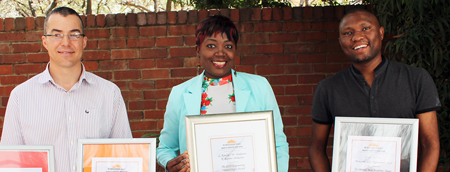
From the left are: Pierre Oosthuizen, Prof Kajimo-Shakantu and Dr Stephan Ramabodu
Photo: Ifa Tshishonge |
The Department of Quantity Surveying at the University of the Free State (UFS) has much to be proud of. With Prof Kahilu Kajimo-Shakantu as Head of the Department of Quantity Surveying, the department is celebrating several firsts.
For the first time, the department has four academics with PhDs. This includes Prof Kajimo-Shakantu, Dr Stephan Ramabodu, Dr Timothy Froise and Dr Benita Zulch. It is also the first time that this department is managed by a woman.
Furthermore, the Department of Quantity Surveying has performed very well at this year’s national Quantity Surveying Conference held in Pretoria, where they walked away with four of the seven awards.
The awards were:
• Best presenter: Pierre Oosthuizen (lecturer)
• Most innovative presenter: Pierre Oosthuizen (lecturer)
• Best paper on engineering projects: Prof Kahilu Kajimo-Shakantu
• Best academic paper: T Monyane (postgraduate student) and Dr Stephan Ramabodu (lecturer)
The South African Council for the Quantity Surveying Profession (SACQSP) also presented two prestigious life achievement awards. One of these were bestowed upon Prof Basie Verster from the UFS for his contribution to quantity surveying since the 1970s.
The university is especially proud of Dr Stephen Ramabodu, lecturer in the Department of Quantity Surveying, who completed his PhD this year. This makes of him the highest qualified quantity surveyor in the department and one of only a few holders of a quantity surveying PhD in the country. Dr Ramabodu is also registered with the South African Council for Quantity Surveying Professionals.
Prof Kajimo-Shakantu said the following of Dr Ramabodu. “Since 2002, Stephan was appointed as a lecturer in a programme called Grow Your Own Timber at the UFS. Later on, he went to Cape Town to gain some commercial experience, where he worked for Davis Langdon in 2005. In 2008, he returned to the Free State, where he established Ramabodu & Associates. Later on in the same year, he returned to the UFS as a lecturer to complete all the remaining milestones of the Grow Your Own Timber programme.
“The university looks forward to Stephen’s increased responsibilities and contributions, not only in teaching and learning, but also in research, mentoring and community engagement.”